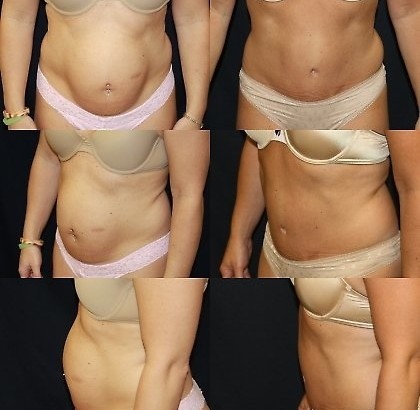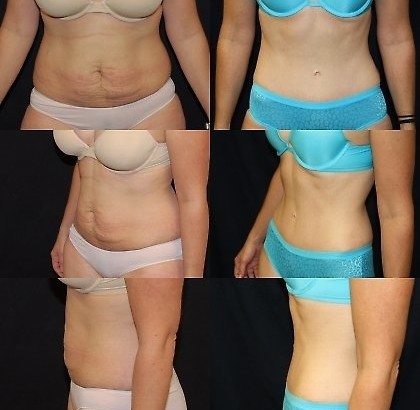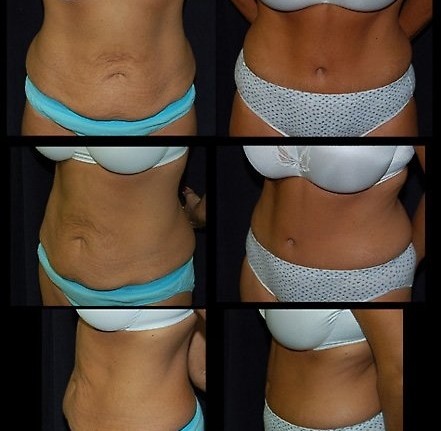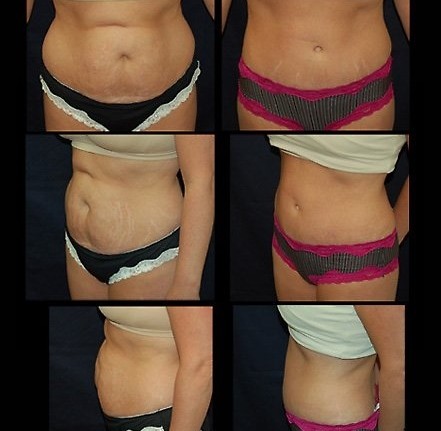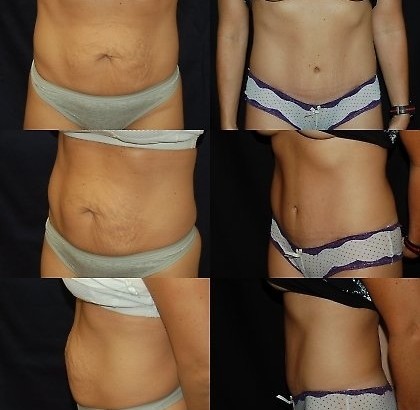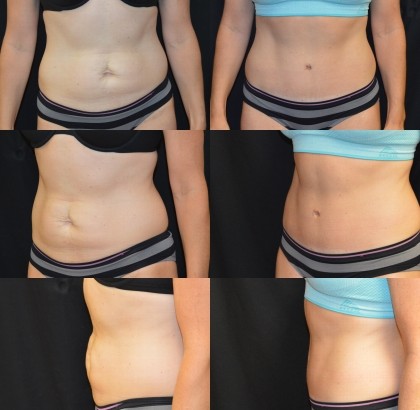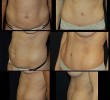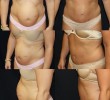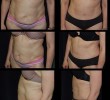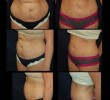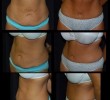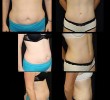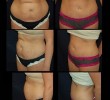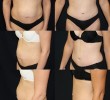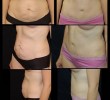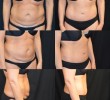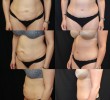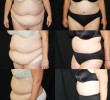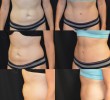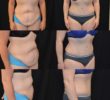Tummy Tuck
Abdominoplasty, known more commonly as a "tummy tuck," addresses three main aspects of the abdomen; skin, subcutaneous fat, and the muscles of the abdominal wall. Abdominoplasty is most beneficial for men or women who are bothered by a large fat deposit or loose abdominal skin that won't respond to diet or exercise. The surgery is particularly helpful to women who, through multiple pregnancies, have stretched their abdominal muscles and skin beyond the point where they can return to normal. Loss of skin elasticity in older patients, which frequently occurs with slight obesity, can also be improved. Diet and exercise should be implemented weeks before surgery and a steady weight established. Not only will weight loss improve your overall result after surgery but will also decrease your risk of experiencing a complication. Women who plan future pregnancies should wait because of stretching the muscles of the abdominal wall.
ALL SURGERY CARRIES SOME UNCERTAINTY AND RISK
Abdominoplasty is a commonly performed operation which may result in dramatic improvements; however, every surgery inherently carries potential risks and complications. Post-operative complications such as infection and blood clots are rare, but may occur. Infection can be treated with drainage and antibiotics, but may require a hospital stay. You can minimize the risk of blood clots by walking as soon as possible after surgery. Poor healing, which results in conspicuous scars, may necessitate a second operation. You can reduce your risk of complications by closely following Dr. Baroody's instructions before and after surgery, especially with regard to when and how you should resume physical activity.
PLANNING YOUR SURGERY
During your initial consultation, Dr. Baroody will evaluate your general health, evaluate the stretch marks/abdominal scars, determine the extent of subcutaneous fat in your abdominal region, and assess underlying muscle weakness. Be sure to inform Dr. Baroody of your past medical/surgical history, all medications you are taking, allergies to medications, and history of tobacco use. According to your anatomy, the most appropriate body contouring procedure(s) will be recommended. Whether you would most benefit from liposuction alone, abdominoplasty with/without liposuction, or a mini-abdominoplasty, Dr. Baroody will weigh the potential results against the potential risks and offer the procedure right for you. During the consultation, Dr. Baroody and his staff will discuss the anesthesia, facility, and the fees involved.
PREPARING FOR YOUR PROCEDURE
You will be given specific instructions on how to prepare for surgery, including guidelines on eating and drinking, smoking, and taking or avoiding certain vitamins, and medications. If you smoke, you must quit at least four weeks before your surgery and not to resume for at least four weeks after your surgery. You must also avoid second-hand smoke. If you smoke or develop a cold/infection of any kind, your surgery will most likely be postponed. Whether your surgery is performed on an outpatient or inpatient basis, you should arrange for someone to drive you home after your surgery, and to help you out for a day or two after you leave the hospital, if needed.
LOCATION OF THE SURGERY
Dr. Baroody performs abdominoplasty procedures in both the hospital and outpatient settings. An Abdominoplasty may be performed in New Milford Hospital or Orthopaedic and Specialty Surgery Center.
TYPES OF ANESTHESIA
Dr. Baroody performs the abdominoplasty procedure under general anesthesia and will numb the abdomen prior to awaking. Dr. Baroody has also written scientific papers and has given presentations on the use of pain pump catheters which slowly infuses numbing medication (like Novocaine) onto the abdominal wall for 2 days after surgery. The use of this catheter is also an option for those concerned about postoperative pain.
THE SURGERY
A standard abdominoplasty usually takes 2-4 hours, depending on the extent of work required. Mini- abdominoplasty may take an hour or two. Most commonly, the incision will be from hipbone to hipbone, just above the pubic area. A second incision is made to free the navel from the surrounding tissue. With mini-abdominoplasty, the incision is shorter and the navel may not be moved, although it may be pulled into an unnatural shape as the skin is tightened and stitched. Next, Dr. Baroody elevates the skin from the abdominal wall all the way up to your ribs and lifts a large skin flap to reveal the vertical muscles in your abdomen. These muscles are tightened by pulling them close together and stitching them into their new position. This provides a firmer abdominal wall and narrows the waistline. The skin flap is then pulled down and the extra skin is removed. The navel is then brought up through the skin flap and stitched in place. Finally, the incisions will be closed with absorbable sutures, dressings will be applied, and two temporary tubes will be inserted to drain excess fluid from the surgical site. During a mini-abdominoplasty, the skin is separated only between the incision line and the navel. This skin flap is pulled down, the excess is removed, and the flap is stitched back into place.
AFTER YOUR SURGERY
For the first few days, your abdomen will be swollen and you're likely to feel some pain and discomfort which can be controlled by medication and an optional pain pump catheter. Depending on the extent of the surgery, you may be released within a few hours or you may have to remain hospitalized overnight. You may only sponge bathe during the first week the drains are in place. And though you may not be able to stand straight at first, you should start walking the night of surgery.
GETTING BACK TO NORMAL
It may take you weeks or months to feel like your old self again. If you start out in top physical condition with strong abdominal muscles, recovery from abdominoplasty will be much faster. Some people return to work after two weeks, while others take three or four weeks to rest and recuperate. Exercise will help you heal better. Even people who have never exercised before should begin an exercise program to reduce swelling, lower the chance of blood clots, and tone muscles.
Vigorous exercise, however, should be avoided until you can do it comfortably. Your scars may actually appear to worsen during the first three to six months as they heal, but this is normal. Expect it to take nine months to a year before your scars flatten out and lighten in color. While they'll never disappear completely, abdominal scars will not show under most clothing, even under bathing suits.
YOUR NEW LOOK
Abdominoplasty, whether partial or complete, produces excellent results for patients with weakened abdominal muscles or excess skin. And in most cases, the results are long lasting, if you follow a balanced diet and exercise regularly. If you are realistic in your expectations and prepared for the consequences of a permanent scar and a lengthy recovery period, abdominoplasty may be just the answer for you. Abdominoplasty, known more commonly as a "tummy tuck," addresses three main aspects of the abdomen; skin, subcutaneous fat, and the muscles of the abdominal wall.
COMMON QUESTIONS
Can an Abdominoplasty eliminate "stretch marks" from my pregnancy?
During a standard Abdominoplasty procedure, the skin from the belly button to the pubic hair line is removed. If the stretch marks are located within the area of the lower abdomen, they will be removed. If the stretch marks extend above the belly button, they cannot be removed but rather relocated further down your abdomen.



